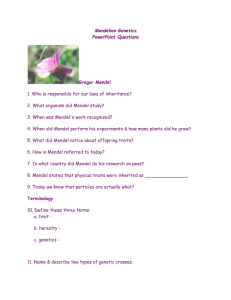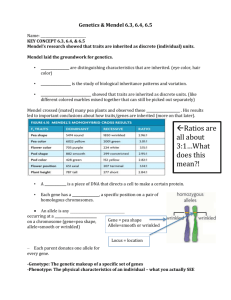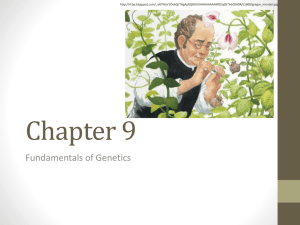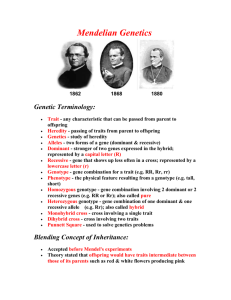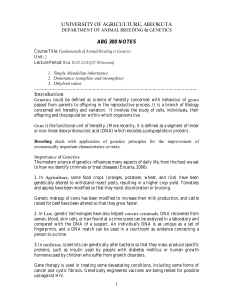Mendelian Genetics PowerPoint Questions Gregor Mendel 1. Who is
advertisement
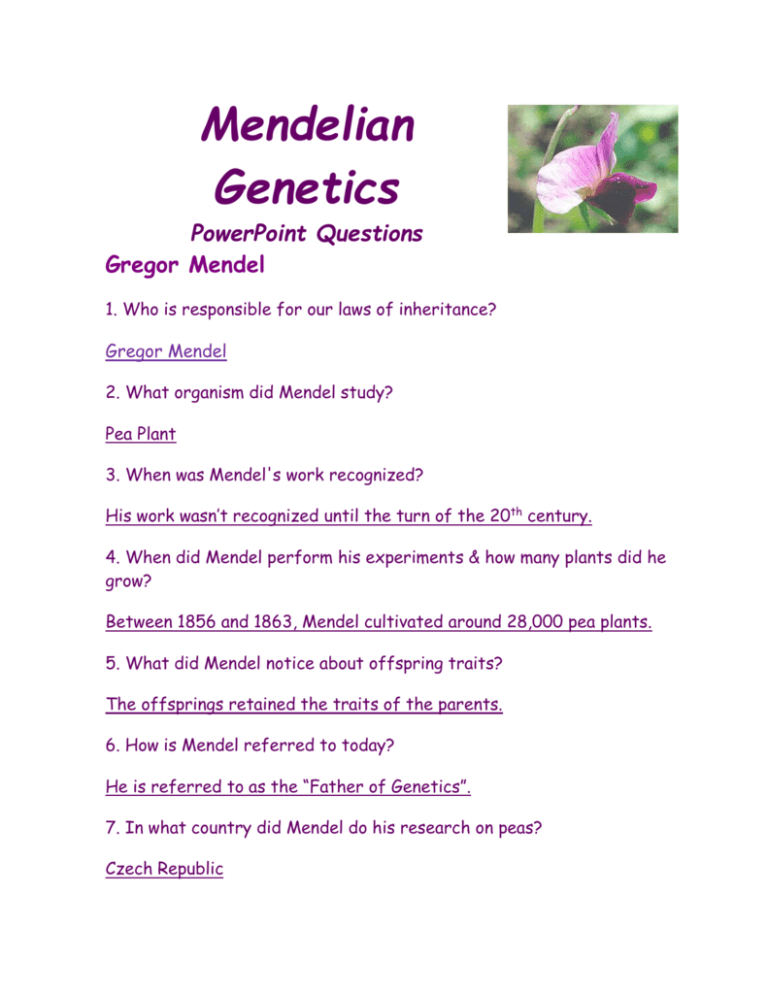
Mendelian Genetics PowerPoint Questions Gregor Mendel 1. Who is responsible for our laws of inheritance? Gregor Mendel 2. What organism did Mendel study? Pea Plant 3. When was Mendel's work recognized? His work wasn’t recognized until the turn of the 20th century. 4. When did Mendel perform his experiments & how many plants did he grow? Between 1856 and 1863, Mendel cultivated around 28,000 pea plants. 5. What did Mendel notice about offspring traits? The offsprings retained the traits of the parents. 6. How is Mendel referred to today? He is referred to as the “Father of Genetics”. 7. In what country did Mendel do his research on peas? Czech Republic 8. Mendel stated that physical traits were inherited as _______________. particles 9. Today we know that particles are actually what? Chromosomes and DNA Terminology 10. Define these three terms: a. trait – any characteristic that can be passed from parent to offspring. b. heredity – the passing of traits from parent to offspring. c. genetics – the study of genetics 11. Name & describe two types of genetic crosses. 1. monohybrid cross-cross involving a single trait. 2. dihybrid cross-cross involving two traits. 12. What is used to solve genetic crosses? Punnet square 13. Sketch a Punnett square & show how they are used to solve a genetics problems. 14. Use a Punnett square to solve a cross between two parents that both have the genotype Yy. The genotype ratio would be 1:2:1 and the phenotype ratio would be 3:1. *See slide #10 of the PowerPoint Presentation. 15. What are alleles & what are the two forms? Alleles are two forms of a gene (dominant and recessive) 16. Explain the difference between dominant & recessive alleles. The dominant gene is the stronger of the two genes expressed in the hybrid (represented by a capital letter). The recessive gene is the weaker of the two genes expressed in the hybrid and shows up less often in a cross. (represented by a lowercase letter). 17. Using a letter of the alphabet, show how each allele would be represented. Dominant: R Recessive: r 18. What is a genotype and write 3 possible genotypes? A genotype is a gene combination for a trait (ex: RR, Rr, rr) 19. What is a phenotype and write possible phenotypes for your genotypes in question 18? A phenotype is the physical feature resulting from the genotype. (ex: red, white) 20. Using these alleles, R = red flower and r = yellow flowers, write all possible genotypes & phenotypes. Genotypes: RR, Rr, and rr Phenotypes: red, white 21. What are homozygous genotypes? A gene combination involving 2 dominant or 2 recessive genes. 22. Write a homozygous dominant genotype. RR 23. Write a homozygous recessive genotype. rr 24. What is meant by a heterozygous genotype? A gene combination of one dominant and one recessive allele 25. Write a heterozygous genotype. Rr 26. Heterozygous genotypes are also called _____________. hybrid 27. What two things actually determine an organism's characteristics? Genes and environment are the two things that determine an organism’s characteristics. Pea Experiments 28. Give 4 reasons that Mendel used garden peas, Pisum sativum, for his experiments. 1. They can be grown in a small area. 2. They produce lots of offspring. 3. They produce pure plants when allowed to self-pollenate. 4. They can be artificially cross-pollenated. 29. Name the male and female parts of a flowering plant and explain how pollination occurs. Male: stamen and it contains sperm. Female: pistil and it contains the ovaries. Pollen carries sperm to the ovaries for fertilization. 30. What is the difference between self and cross pollination? Self-pollination can occur in the same flower. Cross-pollination can occur between different flowers. 31. Explain how Mendel cross pollinated his pea plants. He hand pollinated the pea plants with a paintbrush. He would snip the stamens to prevent self-pollination. Then, covered each flower with a cloth rag 32. How did Mendel get pure plants? He allowed the plants to self-pollinate for several generations. 33. Name 8 pea plant traits and give the dominant & recessive form of each. Seed shape --- Round (R) or Wrinkled (r) Seed Color ---- Yellow (Y) or Green (y) Pod Shape --- Smooth (S) or wrinkled (s) Pod Color --- Green (G) or Yellow (g) Seed Coat Color ---Gray (G) or White (g) Flower position---Axial (A) or Terminal (a) Plant Height --- Tall (T) or Short (t) Flower color --- Purple (P) or white (p) 34. How did Mendel's experimental results compare to the theoretical genotypic ratios? Explain. The theoretical ratio was 3:1. His observed ratio was 2:96:1. The discrepancy was to statistical error. 35. What does P1 mean? Parental generation. 36. What is the F1 generation? The first generation. 37. What is the F2 generation? The second generation. 38. What results from this cross --- TT x tt? All alike. (Tt) 39. What results do you get from crossing two hybrids (Tt x Tt)? 1:2:1 ratio. (RR,Rr,rr) 40. Show all your work for solving a P1 monohybrid cross for seed shape. Trait: Seed Shape Alleles: R- Round r- wrinkled P1 cross: ______RR____ x ____rr______ Rr Rr Rr Rr Genotype _____Rr_______ Phenotype _____Round______ G. Ratio____all alike___ P. Ratio____all alike___ 41. The offspring of the above cross are called the __P1___ generation. 42. Show all your work for solving a F1 monohybrid cross for seed shape. Trait: Seed Shape Alleles: R- Round r- wrinkled F1 cross: ____Rr______ x _____Rr_____ RR Rr Rr rr Genotype ____RR, Rr, and rr________ Phenotype ____Round and wrinkled_______ G. Ratio _______1:2:1______ P. Ratio ______3:1_______ 43. Show all your work for solving both F2 monohybrid crosses for seed shape. Trait: Seed Shape Alleles: R- Round r- wrinkled F2 cross: _____RR___ x ___Rr_____ F2 cross: ___Rr__ x __rr__ Genotype ____RR,Rr____ Genotype _____Rr, rr_______ Phenotype ___Round____ Phenotype __Round and wrinkled G. Ratio ______1:1_____ G. Ratio _____1:1________ P. Ratio _____all alike __ P. Ratio _____ 1:1_______ Mendel's Laws Complete the following question: 44. _________ are responsible for inherited traits. Genes 45. Phenotype is based on _______________. Genotype 46. Each trait requires _____ genes, one from each ____________. Two, parent 47. State the Law of Dominance and give an example. In a cross of parents that are pure for contrasting traits, only one form of the trait will appear in the next generation. 48. State the Law of Segregation and tell when alleles are "recombined". During the formation of gametes (eggs or sperm), the two alleles responsible for a trait separate from each other. 49. State the Law of Independent assortment & tell what type of crosses show this. Alleles for different traits are distributed to sex cells (& offspring) independently of one another. 50. Using the formula 2n where n = the number of heterozygotes, tell how many gametes will be produced by each of the following allele combinations: a. RrYy: 4 gametes b. AaBbCCDd: 8 gametes c. MmNnOoPPQQRrssTtQq: 64 gametes 51. What are the possible allele combinations in the egg and sperm from the following cross --- RrYy x RrYy. 52. Show how to work an F1 dihybrid cross for seed shape & seed color. Traits: Seed shape and Seed color Alleles: R: round, r: wrinkled, Y: yellow, y: green F1 cross ___RrYy_______ x _____RrYy_____ RRYY RRYy RrYY RrYy RRYy RRyy RrYy Rryy RrYY RrYy rrYY rrYy RrYy Rryy rrYy rryy GR Genotypes PR Phenotypes 9:3:3:1 Phenotypic ratio 53. Complete this cross or crosses for eye color & curliness of the hair --- bbC__ x bbcc. * Refer to slide #54 on the powerpoint. 54. Draw a table summarizing Mendel's 3 laws. * Refer to slide #55 on the powerpoint. Incomplete and Co-Dominance 55. Incomplete dominance occurs in __________ and produces a phenotype _______________ the phenotype of the two parents. 56. Show your work solving a cross for flower color in snapdragons when there is incomplete dominance. Trait: Flower color Alleles: R-red r-white Cross: RR x rr Rr Rr Rr Rr Genotype _____Rr_______ Phenotype ____pink_______ G. Ratio _____all Rr_______ P. Ratio ___all pink________ 57. What is codominance & give an example? Two alleles are expressed (multiple alleles) in heterozygous individuals. Example: blood type 58. Write the genotypes for each of these blood types: type A- IAIA or IAi type B- IBIB or IBi type AB- IAIB type O- ii 59. Solve this codominance problem: IBIB x IAi. 1/2 = IAIB 1/2 = IBi 60. Solve this codominance problem for blood type: ii x IAIB. 1/2 = IAi 1/2 = IBi Sex-Linked Traits 61. What are sex linked traits? Genes that are located on the sex chromosomes. 62. Name the sex chromosomes. X and Y. 63. Write the genotype for male and for female. XX: female Xy: male 64. Most sex-linked traits are carried on what chromosome? Most are carried on the X chromosome. 65. Give an example of a sex-linked trait in fruit flies. Eye color in fruit flies. 66. Show the results of crossing a red-eyed male (XRY) with a whiteeyed female (XrXr) fruit fly. RR = red eye Rr = red eye rr = white eye XY = male XX = female Cross: ____ XRY ______ x ____ XrXr ______ XR Xr XR Xr Xr Y Xr Y Genotype _____ XR Xr , Xr Y _______ Phenotype __Red and White_________ G. Ratio ______1:1_______ P. Ratio _______1:1________ 67. What is meant by a female carrier? In sex-linked traits (like hemophilia), women are carriers, men have the phenotype more often. 68. Name a disease that can be carried in this manner. Hemophilia.


